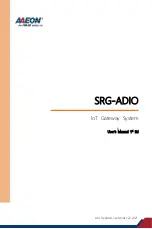
Page 41 / 141
DTUS065 rev A.7 – June 27, 2014
all devices on the bridged LAN appear to have the same MAC address
(the one of the bridge radio card) but different IP addresses. The solution
is to
disable the proxy ARP server on the AP side
. In the CISCO
product this is called “passive client mode”.
6)
More generally, applications or protocols running on the backbone side
and relying on MAC addresses to identify devices, will encounter
problems in this mode. Fortunately such software is hardly used.
V.6.2.2
Infrastructure client using 4 addresses format (WDS)
When the client is in 4 addresses format bridging mode, it uses a special
frame header where both Wi-Fi and LAN MAC addresses are indicated.
This is called the “4-addresses frame format”. By conveying both the client
MAC and the wired device MAC in the wireless frame, the client can
correctly route Wi-Fi frames to its LAN while the AP can know that it sends
to an authenticated client.
4-addresses frame format
In this solution to the bridging problem, the client bridge and the AP
encapsulate both data and Ethernet MAC addresses in the Wi-fi frame,
adding both the AP and the client Wi-Fi MAC addresses. So the frame can
reach its Wi-Fi destination, which removes the Wi-Fi addresses and retrieves
the original frame unchanged. The same process takes place both ways.
This has the big advantage of being independent of the layer 3 IP addresses:
1)
This mode can bridge protocols other that TCP/IP.
2)
It transfers DHCP and ARP frames unchanged, avoiding most
verification issues on the AP side, like proxy ARP or DHCP servers.
3)
It allows using an IP gateway either on the AP side or on the bridge side,
accessible from either side.
But since this solution relies on unspecified 802.11 features, is should be
used only between products of the same brand or range, or when you know
that the AP and client use compatible software.
Final note:
The 4-addresses frame format is sometimes called WDS
(wireless distribution system). This acronym designates a frame format that
can be used in a variety of ways. It does NOT designate a specific Wi-Fi
architecture (like infrastructure or mesh).
Configuration
The WLn access points (AP) always support both standard and transparent
clients simultaneously. The WLn client bridges must be set up as either
standard clients or transparent clients.
















































